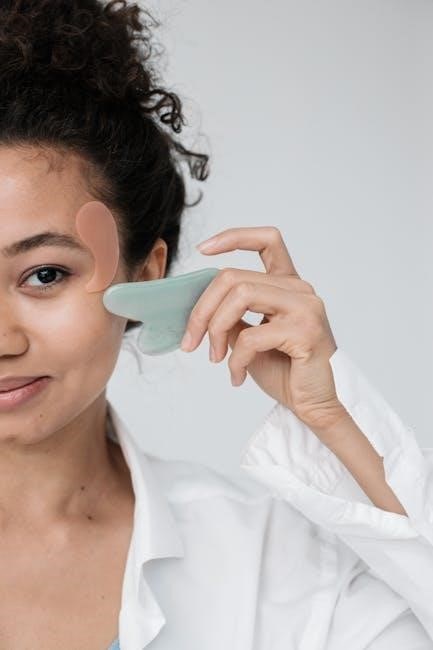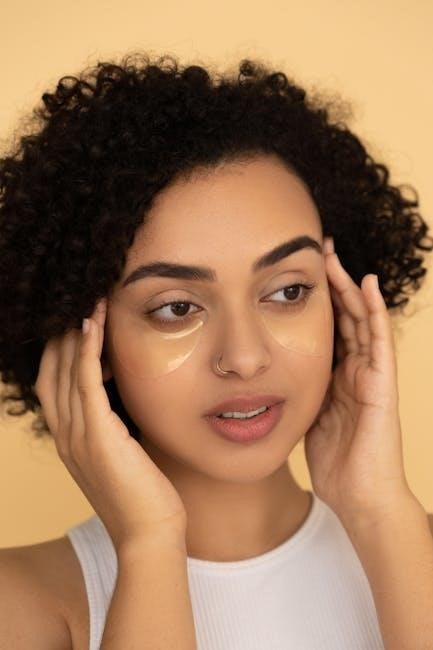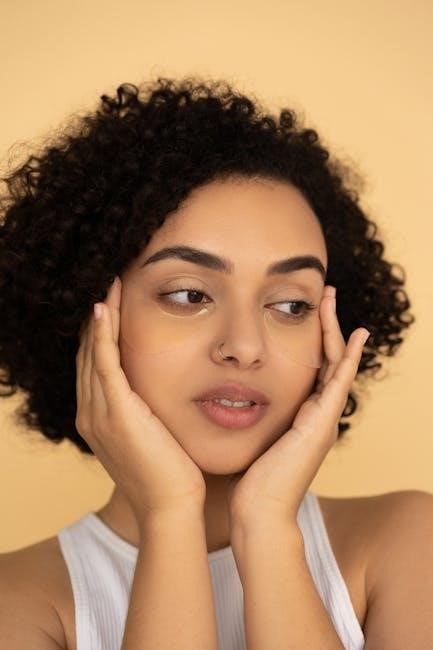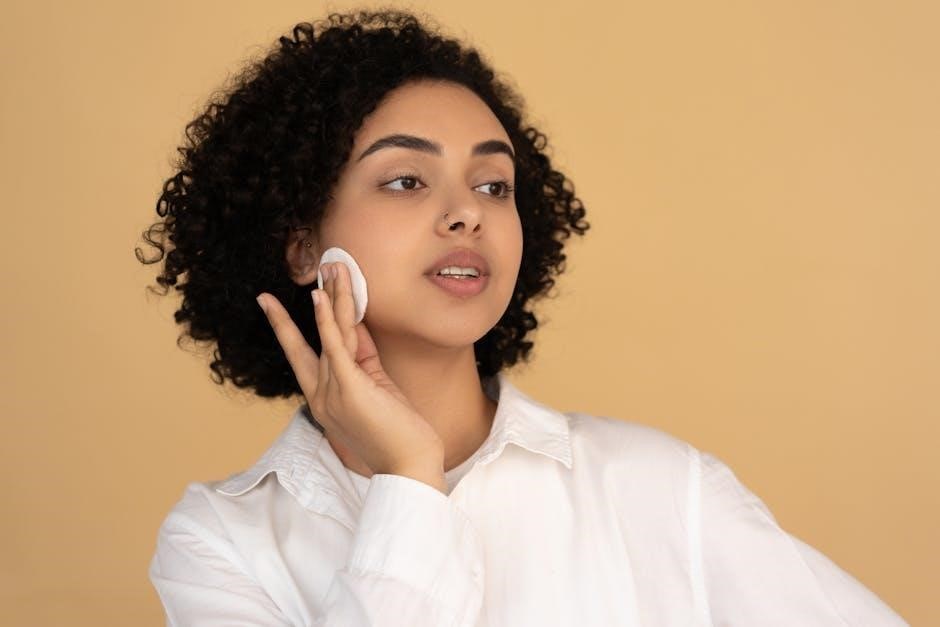Gua Sha is an ancient healing technique using tools to scrape the skin, promoting blood flow and lymphatic drainage. It originated in traditional Chinese medicine, offering natural health benefits and skincare improvements through gentle, intentional strokes. This practice has gained modern popularity for its holistic approach to wellness and aesthetic enhancement.
1.1 What is Gua Sha?
Gua Sha is a traditional Chinese healing technique that involves scraping the skin with a specially designed tool to improve circulation and promote lymphatic drainage. The practice, which translates to “scrape sand,” aims to remove stagnant energy, or “chi,” from the body. By applying gentle, repeated strokes, Gua Sha stimulates blood flow, reduces inflammation, and enhances overall well-being. It is often used to relieve pain, address skin concerns, and support immune function, making it a versatile and natural self-treatment method rooted in ancient medicine.
Benefits of Gua Sha
Gua Sha improves circulation, reduces inflammation, and relieves muscle tension. It enhances lymphatic drainage, promoting detoxification and radiant skin. Regular practice boosts energy and overall well-being.
2.1 Key Benefits for Skin and Health
Gua Sha significantly enhances skin health by reducing puffiness and toning facial muscles, creating a sculpted appearance. It improves lymphatic drainage, which detoxifies the body and boosts radiance. Regular practice stimulates blood circulation, minimizing acne and promoting collagen production. For overall well-being, Gua Sha eases muscle tension, alleviates headaches, and combats colds. Its holistic approach supports energy flow, enhancing vitality and mental clarity. By addressing both skin and health, Gua Sha offers a natural, effective solution for long-term wellness and aesthetic improvement.

Tools and Equipment for Gua Sha
Gua Sha tools are typically made from materials like jade, rose quartz, or stainless steel. These tools feature smooth, curved edges designed for gentle scraping motions.
3.1 Best Tools for Self-Treatment
The best tools for Gua Sha self-treatment include jade scrapers, rose quartz tools, and stainless steel combs. Jade and rose quartz are popular for their smooth edges and cooling effects, while stainless steel offers durability. Ergonomic handles enhance comfort during use. These tools are designed to glide over the skin gently, making them ideal for facial and body treatments. Proper tool selection ensures effective stimulation of blood circulation and lymphatic drainage, which are key to achieving the benefits of Gua Sha;
Gua Sha Techniques and Strokes
Gua Sha involves gentle pushing, lifting, and pressing strokes to stimulate blood flow and lymphatic drainage, enhancing circulation and relief.
4.1 Proper Techniques for Effective Treatment
Use a flat tool at a 15-20° angle, applying light pressure in upward, downward, or circular strokes. Focus on key areas like the neck, face, and shoulders. Work gently to avoid bruising, ensuring smooth, even movements. Practice consistent, rhythmic strokes to enhance lymphatic drainage and blood flow. Avoid sensitive areas and bony prominences. Start with soft pressure and gradually increase as needed for comfort. Regular practice promotes relief, relaxation, and improved circulation, making it an effective self-care routine for overall wellness.
Target Areas for Gua Sha
Common target areas include the face, neck, shoulders, and back. These regions benefit from improved circulation, reduced tension, and enhanced lymphatic drainage, promoting overall well-being.
5.1 Key Areas to Focus On
The face, neck, and shoulders are primary areas for Gua Sha, as they hold tension and benefit from improved circulation. Use gentle strokes on the face to enhance lymphatic drainage and contouring. The neck and shoulders respond well to firm, upward strokes, relieving stress and muscle knots. For full-body practice, focus on the back, arms, and legs to release toxins and ease pain. Always adjust pressure based on sensitivity and avoid bony areas to ensure safe, effective treatment.

Safety Precautions and Contraindications
Avoid Gua Sha on broken skin, varicose veins, or sensitive areas. Use light pressure to prevent bruising. Skip areas with open wounds or active acne.
6.1 Important Safety Tips
Start with gentle pressure and gradually increase as needed. Avoid sensitive areas like the eyes and mouth. Use a clean, lubricated tool to minimize friction. Hydrate your skin beforehand for better glide. Avoid Gua Sha on broken skin, varicose veins, or active acne. Stop if discomfort occurs. Cleanse your tool after each use to prevent infection. Avoid treating the same area repeatedly to prevent bruising. Consult a professional if unsure about specific conditions. Gua Sha should complement, not replace, medical treatments. Always prioritize skin health and safety during practice.
Incorporating Gua Sha into Your Routine
Start with short sessions, ideally once daily, using gentle strokes. Cleanse your tool and skin beforehand. Focus on key areas like the face and neck. Be consistent for visible results and improved well-being over time.
7.1 How to Make Gua Sha a Daily Routine
Common Mistakes to Avoid
Common mistakes include using excessive pressure, neglecting lubrication, and improper tool handling. Start gently, use oil, and avoid sensitive areas to prevent bruising or discomfort.
8.1 Tips for Avoiding Errors
To avoid errors, begin with light pressure and gradually increase as needed. Always use a lubricating oil or serum to reduce friction and prevent skin irritation. Ensure the tool is held at a 15-20 degree angle to the skin for effective scraping. Avoid applying Gua Sha over broken skin, open wounds, or sensitive areas. Practice on one area at a time, observing your skin’s response. Consistency is key, but over-treatment can lead to bruising or discomfort. Listen to your body and adjust techniques accordingly for a safe and beneficial experience.

Expected Results and Outcomes
Regular Gua Sha practice promotes radiant, smooth skin, reduced facial puffiness, and toned muscles. It enhances lymphatic drainage, alleviates tension, and may improve overall well-being over time.
9.1 What to Expect from Regular Practice
Regular Gua Sha practice yields noticeable improvements in skin health and overall well-being. It enhances blood circulation, reducing facial puffiness and promoting a radiant complexion. Over time, it tones facial muscles, sculpting a more defined appearance. Consistent use can lead to improved lymphatic drainage, reducing the risk of congestion and breakouts. The skin becomes smoother, with a natural glow. Additionally, Gua Sha helps alleviate tension, contributing to a more relaxed and balanced state of mind. With dedication, these effects accumulate, offering a holistic approach to both beauty and health.
The History and Cultural Significance of Gua Sha
Gua Sha has ancient roots in traditional Chinese medicine, used for centuries to enhance health and beauty, symbolizing its rich cultural heritage and enduring therapeutic value.
10.1 Origins and Traditional Use
Gua Sha traces its origins to traditional Chinese medicine, with roots in ancient healing practices. It was widely used in rural villages as a natural remedy for various ailments, employing simple tools like coins or stones to scrape the skin. This technique was believed to balance energy, or “qi,” and promote healing. Practitioners would apply Gua Sha to relieve pain, reduce inflammation, and improve circulation, making it a staple in holistic health.
Historically, Gua Sha was also used for its aesthetic benefits, with materials like jade and buffalo horn being favored for their cooling properties. Over time, its popularity spread beyond China, adapting to modern wellness routines while retaining its traditional essence. Today, it bridges ancient wisdom with contemporary self-care, offering a timeless approach to health and beauty.
Combining Gua Sha with Other Practices
Gua Sha enhances well-being when paired with acupuncture, herbal remedies, or meditation. These combinations improve circulation, reduce stress, and boost energy for a holistic wellness approach.
11.1 Enhancing Results with Other Wellness Practices
Gua Sha pairs well with acupuncture, herbal remedies, and meditation to amplify its benefits. Acupuncture targets specific energy points, while Gua Sha enhances circulation. Herbal remedies support skin health and relaxation. Combining Gua Sha with sound therapy or breathwork can deepen relaxation and improve lymphatic drainage. For optimal results, incorporate Gua Sha into your routine before or after meditation. These combinations create a holistic approach, boosting energy, reducing stress, and promoting overall well-being. Regular practice with complementary therapies enhances Gua Sha’s effectiveness, offering a comprehensive path to improved health and radiant skin.

Troubleshooting Common Issues
If experiencing discomfort or bruising, adjust pressure or technique. Ensure proper tool selection and gentle strokes. Addressing issues promptly prevents side effects and enhances benefits.
12.1 Addressing Discomfort or Side Effects
If discomfort arises during Gua Sha, reduce pressure or adjust technique. Bruising may occur but typically fades within days. Avoid sensitive areas and broken skin. Ensure proper tool hygiene to prevent irritation. Applying a gentle massage oil can reduce friction. If pain persists, consult a professional. Side effects are usually mild and temporary, resolving on their own. Prioritize gentle strokes and avoid over-treating the same area. Proper training and technique minimize risks, ensuring safe and effective practice.
Consistency and patience are key to maximizing Gua Sha’s benefits. Regular practice promotes improved well-being, radiant skin, and a natural, empowering approach to self-care.
13.1 Maximizing the Benefits of Gua Sha
To fully harness Gua Sha’s potential, combine it with a consistent skincare routine and healthy lifestyle. Use gentle, upward strokes on the face to enhance lymphatic drainage and reduce puffiness. For the body, focus on areas with tension or pain, scraping in the direction of muscle fibers to relieve stiffness. Incorporate breathing exercises during sessions to deepen relaxation and improve circulation. Regular practice, ideally 3-4 times a week, will yield noticeable improvements in skin health and overall well-being over time.
